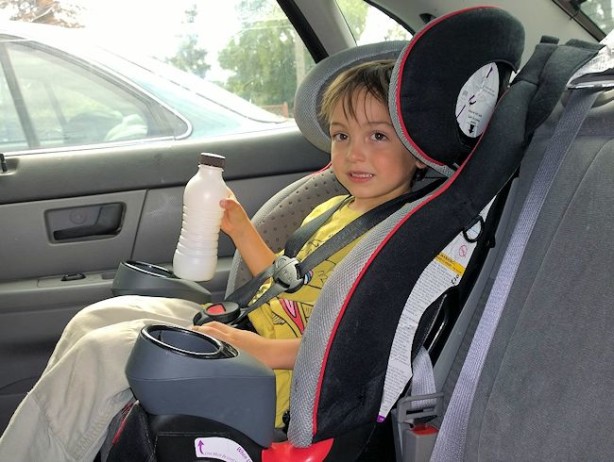Every time a parent gets behind the wheel with their child in the vehicle, they carry the most precious cargo imaginable.
The road can be unpredictable, and the responsibility of ensuring a child’s safety in a car is paramount.

If you’re wondering about the best ways to keep your children safe in the car, read on to learn about the complexities of driving safely with children, along with a breakdown of the best practices, laws, and recommendations surrounding child passenger safety.
Choosing the right car seat, handling in-car distractions and teaching kids about road safety outside the car can all help ensure you’re ready to hit the road safely.
With the right tools and information, you’ll be better able to make every journey a safe one for your little ones.
Understanding Child Passenger Safety Laws
Child passenger safety laws have evolved since the 1960s, transitioning from mere seat elevations to stringent safety regulations.
While the core emphasis is universal child protection, specific laws vary by state or country, with potential differences in age, weight, height, or seat type requirements.
Parents should make it a priority to stay updated with local rules through transportation or child safety organization websites.
Non-compliance doesn’t only risk a child’s safety, it can also lead to legal repercussions, from fines to potential endangerment charges.
Prioritize adhering to these laws to both avoid legal consequences and ensure to ensure your child’s utmost safety during travel.
Choosing the Right Child Safety Seat
Child safety seats come in a range to cater to the diverse needs of growing children:
- Infant Car Seats: Designed for newborns and small babies, these rear-facing seats are suitable for children up to a certain weight (typically around 20-35 pounds), depending on the model.
- Convertible Seats: These seats can transition from rear-facing for infants to forward-facing for toddlers. Their weight and height specifications are broader, catering to longer usage.
- Booster Seats: For children who have outgrown car seats but aren’t tall enough for regular seat belts. They raise the child’s seating position for an optimal seatbelt fit.
Choosing the right seat involves considering the following:
- Child’s Age: Different age groups require distinct seat types for optimal safety.
- Weight & Height: Each seat type has specific weight and height restrictions.
- Car Compatibility: Ensure the chosen seat fits and can be securely installed in your vehicle model.
Properly Securing Your Child in the Vehicle
Choosing the right car seat is only the first step in ensuring child safety in a car. Securing your child properly is an often-overlooked task that’s just as important.
Always ensure harnesses are snug, lying flat without twists. Use the chest clip positioned at armpit level to prevent slippage.
For forward-facing seats, the harness straps should pull from at or above the child’s shoulder, while for rear-facing seats, they should be at or below.
The pinch test, where you shouldn’t be able to pinch any slack in the harness at the child’s collarbone, can be a quick check of snugness. As children grow, regular adjustments are vital.
A child’s winter coat or bulky clothing can interfere with proper fit, so always properly buckle the child first and then place a blanket or coat over them for warmth.
Remember, the tighter and more precise the fit, the better protection during a collision.
Age-Appropriate Car Safety Tips
Ensuring child safety in a car involves adapting to the growing needs of children. Here are age-specific tips to ensure optimal protection:
- Infants:
- Always use rear-facing seats. They provide the best support for an infant’s head, neck, and spine.
- Ensure the car seat angle is correct, generally between 30-45 degrees, to prevent the child’s head from flopping forward.
- Avoid adding aftermarket products, like head supports, unless they come with the seat or are approved by the seat manufacturer.
- Toddlers:
- Transition to forward-facing seats only once they exceed the rear-facing seat’s weight or height limit.
- Use the tether strap for additional security in forward-facing installations.
- Regularly check the harness fit, as toddlers grow quickly and adjustments may be needed frequently.
- Young Children:
- Once children outgrow forward-facing seats, shift them to booster seats.
- The seatbelt should lie snugly across the upper thighs, not the stomach, and across the shoulder, not the neck.
- Ensure they remain in the booster until they’re tall enough for seat belts to fit properly without it, usually when they’re at least 4’9″ tall.
- Older Children:
- When transitioning out of a booster seat, the vehicle’s seat belt should fit a child properly.
- Ensure the lap belt lies snugly across the upper thighs, and the shoulder belt runs across the chest and shoulder.
- They should ideally sit in the back seat until age 13 for maximum safety.
Addressing Common Distractions
Driving with children can come with all kinds of distractions, from sudden outbursts of crying to sibling disputes.
However, staying focused on the road is imperative for safety.
Equip your car with essential items within arm’s reach, such as tissues or pacifiers, to quickly address minor issues.
For older children, pre-plan entertainment like audiobooks, soft toys, or travel games to keep them engaged.
If a situation requires more attention, like a diaper change or settling a disagreement, always find a safe place to pull over rather than attempting to resolve it while driving.
Remember, maintaining focus on driving ensures the safety of everyone on board.
Additional Safety Tips
Navigating the road with children requires constant vigilance, both inside and outside the vehicle.
Here are a few additional safety measures every parent should keep in mind:
- Windows and Doors: Engage child safety locks to prevent children from opening doors during transit. Teach them the dangers of playing with windows to avoid potential injuries.
- Unattended Children: Never leave a child unattended in a vehicle, even for a short duration. Temperatures inside a car can rise rapidly, leading to heatstroke or other serious risks.
- Vehicle Exit Safety: Teach children to always exit the vehicle on the curb side to avoid oncoming traffic, and to always look around before stepping out.
- Parking Lot Caution: Hold your child’s hand in parking lots. Kids often go unnoticed by drivers in parking areas.
- Power Windows: Ensure that power windows are out of children’s reach or disabled when not in use to prevent fingers or limbs from getting caught.
- Check Around Vehicle: Before driving, especially when backing up, always check around and beneath the vehicle to ensure no child is around or behind the car.

Conclusion
Ensuring child safety in a car is a paramount responsibility. Every aspect of safe driving plays a crucial role in reducing risks and safeguarding their well-being.
By staying informed, being prepared for emergencies, and instilling good habits, we can create a secure environment for our children on and off the road.
And that will help to make every vehicle journey a more safe and memorable experience for them.
